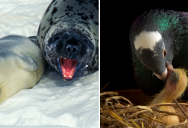These Animals Make The Most Bizarre Milk For Their Offspring

As we know from the critically acclaimed film Meet the Parents, you can milk anything with nipples.
You can also milk snakes and other venomous animals.
That said, you might be surprised by some of the weirder “milks” that come out of the animal kingdom, though.
First up, platypuses, who make the “sweatiest” milk on the market.

No one should be surprised to find the platypus on this list, since they are weird in pretty much every way imaginable. In fact, when they were first documented, the people on the receiving end of the drawings and details thought it was a hoax.
Although platypodes don’t have traditional nipples, they do sort of secrete milk directly through the surface of their skin. The babies lap the milk where it collects in the grooves and creases, or suck it off their mother’s fur.
Janet Newman, a scientist at Australia’s national science agency CSIRO, agrees that this kind of makes sense.
“Platypus are such weird animals that it would make sense for them to have weird biochemistry. By taking a closer look at their milk, we’ve characterized a new protein that has unique antibacterial properties with the potential to save lives.”
She is leading research into whether or not a unique protein structure in that milk could help bolster our current antibiotic weaponry.
Next, we have the makers of the fattiest milk: hooded seals.

All milk has some fat content, but the amount can vary quite a lot. The animal with the skinniest milk is the black rhino, coming in at around 0.2%.
The hooded seal is on the opposite end of the spectrum, who produce milk that’s around 60% fat – nearly twice what’s in heavy cream.
They have to pack a lot in there, because they only nurse their pups for around 4 days. The fat content and the amount of milk they consume enables the babies to gain around 15 pounds in that first half-week.
The pups consume about 60,000 kcal every day, says a 2023 paper.
“This energy consumption equivalent would be similar to a 6-year-old human consuming 109 McDonald’s Big Macs per day for 4 days, although the fat percentage would still be less than hooded seal milk.”
Did you know pigeons make milk?

Neither did I, but they’re one of three bird species that produce something called “crop milk.” This is due to the fact that it comes out of the crop, a little pouch at the base of their throat that stores food prior to digestion.
Experts promise it’s not vomit; it is more similar to milk in both production and composition.
Crop milk is stimulated by hormone prolactin and is the only food the newborn bird will consume. It’s designed to nourish a developing baby and scientists have been unable to replicate it in a lab.
We do know that it contains specific antioxidants and immune-boosting antibodies, and those don’t only benefit the babies, says Meagan Gillespie, a CSIRO researcher.
“It is possible that they are directly enhancing the immune system of the developing squab as well as protecting the parental crop tissue.”
It’s similar to cottage cheese in consistency, so it isn’t likely humans will try to steal and market it anytime soon.
Besides that, the squabs only eat it for about 10 days – from both moms and dads.
Go pigeons.
Jumping spiders have experienced a revolution in past years, with some people even keeping them as pets. They also, as it turns out, make milk.

In 2017, researchers found that female jumping spiders, who lay around 36 eggs at a time, deposit little bits of milk around the nest for the babies to find.
Once they do, they feed directly from the mama spider.
The milk contains fats, sugars, and proteins – it’s about four times as protein-rich as cow’s milk – but other than that, it’s composition remains a bit of a mystery.
Lastly, the hippo.

You might have heard a rumor that hippo milk is pink, like their “blood sweat” that is neither blood nor sweat but does help protect them from the sun.
It’s not.
Hippo milk is white(ish), but the rumor might have come from instances of the milk mixing with the blood sweat on the hippo’s body.
“While that’s possible, it’s also petty unlikely, as baby hippos are very efficient eaters. They grip mom’s nipple between the tongue and the roof of the mouth, forming such a tight bond that they can even nurse underwater if they wish.”
The way this nursing mom just flinched, y’all.
You do not want to get close enough to a hippo to find out for yourself – they’re happy to attack any time of year, but females who are nursing don’t even need to pretend to have a reason.
So, there you have it. I know I learned a thing or two.
Thought that was fascinating? Here’s another story you might like: Why You’ll Never See A Great White Shark In An Aquarium

Sign up to get our BEST stories of the week straight to your inbox.




